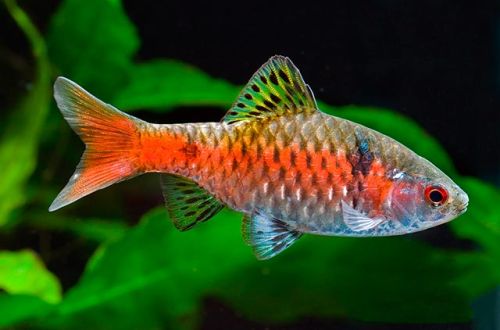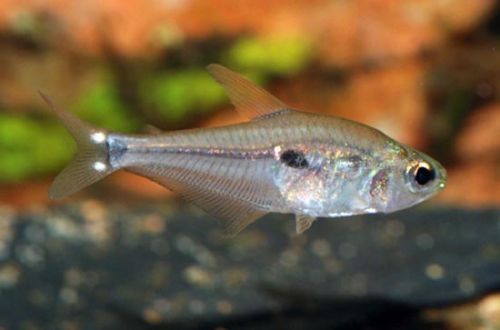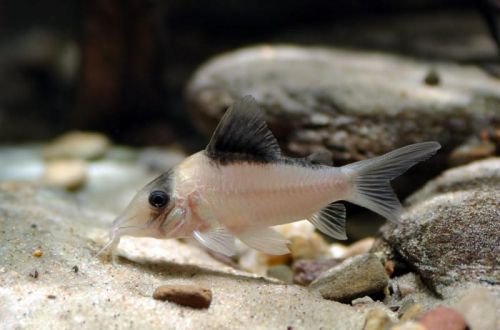
Barbus Odesa
Barbus Odessa or Odessa Barbus, scientific name Pethia padamya, belongs to the Cyprinidae family. Despite its name, this fish does not live in Ukraine. It has been available in the aquarium trade since the 1970s, but its exact origin was not known until 2003, and since this species of Barbusov first came on sale from Odessa, the name of this port city stuck with him in colloquial speech.

Contents
Habitat
It comes from Southeast Asia from the territory of modern Myanmar (Burma). Occurs in the basin of the river Chindwin – one of the largest in this region. The river flows through mountainous/hilly limestone terrain, so the water has a high hardness index (dGH). The natural habitat is characterized by rocky substrates and few aquatic plants. Wild fish were collected at an altitude of over 3000 meters.
Brief information:
- The volume of the aquarium – from 80 liters.
- Temperature – 16-25°C
- Value pH — 6.0–8.0
- Water hardness – 5–20 dGH
- Substrate type — stony
- Lighting – low, moderate
- Brackish water – no
- Water movement – light or moderate
- The size of the fish is about 4 cm.
- Feeding – any food of suitable size
- Temperament – peaceful
- Keeping in a group of 8-10 individuals
Description
Adults reach a length of about 4 cm. Males have a bright red color. The fins have black dots. The body pattern also has a black vertical stripe behind the gill cover. Females are larger, the color is not so bright, but the body pattern is more pronounced, and the scales have a black border.
Food
Omnivorous species, accepts most popular foods designed for aquarium fish. The quality and composition of the products directly affect the brightness of the color, so it is recommended to purchase food from well-known manufacturers that contain the necessary vitamins and minerals.
Maintenance and care, arrangement of the aquarium
The optimal size of the aquarium for a small flock of fish starts from 80 liters. The design is arbitrary, selected at the discretion of the aquarist or from the needs of other fish. It is noted that dark soil and subdued light contribute to the manifestation of more saturated colors in color, and on the contrary, bright light makes the fish dull.
The maintenance of Odessa Barbs is simple and does not require large time and financial costs. To maintain stable habitat conditions, several standard procedures will be required: weekly replacement of part of the water with fresh water, regular cleaning of organic waste, monitoring the pH / dGH / oxidizability parameters.
Behavior and Compatibility
Peaceful active fish, compatible with other non-aggressive species of comparable size, able to live in similar conditions. It is recommended to acquire a mixed (male and female) flock of at least 8-10 individuals and maintain the group size at this level.
Breeding / breeding
The process of reproduction in Barbs Odessa is typical for most cyprinids. With the onset of the mating season, the females scatter the eggs in the water column, and the males fertilize them at this time. The eggs sink to the bottom and from that moment they begin to become left to their own devices. The incubation period lasts 24-48 hours, after another day the fry that have appeared begin to swim freely. Since adult fish have not developed parental instincts, they will happily eat their own offspring, which is why the survival rate of fry in a common aquarium is minimal.
If you plan to save fry, then you will need to prepare in advance a separate tank with identical water conditions – a spawning aquarium, where eggs are placed at the end of spawning. Usually this is a small container (about 10 liters) equipped with a simple airlift filter with a sponge and a heater. A separate light source is not required. Artificial plants or shade-loving aquatic mosses, ferns are suitable as decoration.
Fish diseases
In a balanced aquarium ecosystem with species-specific conditions, diseases rarely occur. Diseases are caused by environmental degradation, contact with sick fish, and injuries. If this could not be avoided, then more about the symptoms and methods of treatment in the section “Diseases of aquarium fish”.





